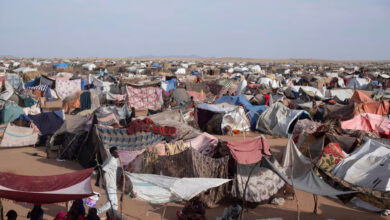Riding through Juba, you may be tempted to think that history began with the 2005 Peace Agreement. But there’s far more to this unusual city than an international organization circus–the Sudanese are struggling to build a nation, in the midst of severe political and economic uncertainty. Visiting Juba is fascinating by every possible measure.
This is Part I of a two-part story from Juba, Southern Sudan.
“No no no! No photo! Do you see all the men with guns? Do you want us to kill you?” yelled a gesticulating soldier, menacingly walking straight toward me.
A charming welcome at the Juba airport, as I tried to snap a couple of photos of the electoral posters hanging by the tarmac upon exiting the plane. I sighed, deleted the photos, and showed my camera to the man–something I’d have to do several times over the course of the following days.
Welcome to Southern Sudan, Africa’s latest country-on-hold.
A severely underdeveloped region, the Southern part of Egypt’s southern neighbor, covers an area of 640,000 square kilometers–two thirds of Egypt’s land mass–and has been in and out of war for half a century, from Sudan’s independence in 1956 until 2005.
For several years, Southern Sudan has operated largely as a de-facto independent country. Its regional government–the Government of South Sudan, or GOSS–has been noisily, but very slowly, building up its capacity in readiness for the day it is put in charge of an independent state–which will likely be the case within half a year.
Most of the interest of the Southern Sudanese is thus focused on building their national nucleus, rather than worrying about the politics of Khartoum.
Juba is the capital of Southern Sudan–and the heartland of the Nuer tribe, Southern Sudan’s second largest tribe.
The choice of the capital was a deliberate, and intelligent, nation-building move on the part of the leaders of the Sudanese People Liberation Army/Movement (SPLA/M). These people led the civil war for its last 25 years, and were themselves members of the larger, dominant Dinka tribe. In choosing Juba, they meant to assure other, smaller tribes that the Dinka did not intend to hog power once independence was achieved.
Until 2007 the only paved road in Juba was the airport road. Since then however, with the influx of the oil money, of which GOSS now controls 49 percent, in addition to international development assistance, construction is underway.
Huts remain however the primary dwelling of the Southern Sudanese.
With the rapid influx of international NGO and intergovernmental agency workers–evidenced by Range Rovers whizzing around and the number of foreigners in town–a parallel economy was bound to emerge, with dedicated security, transportation, food and other service industries operating, in effect, in parallel with the local economy. This has led to imported inflation, to the detriment of the locals.
Juba now boasts, for instance, not one but two Chinese restaurants–and yes, there is something utterly ridiculous about paying US$20 for Thai chicken with cashew nuts served by a Filipina waitress, all-imported–the chicken, the cashew, and the waitress–in a new-agey restaurant, guarded by former soldiers wearing the uniform of a security company, while in one of the planet’s poorest locations.
Juba’s hotel rooms, of perhaps a two-star standard, retail for an average of US$100 a night, sometimes more, while in the immediate aftermath of the 2005 Comprehensive Peace Agreement (CPA) and with the first influx of foreign aid workers, a night in a camping tent cost as much as US$150.
Very little of this money seems to trickle outside of Juba, however. Torit, capital of the neighbouring Eastern Equatoria state, is about 120 kilometres away from Juba, but the unpaved road takes about four hours, and up to twice that, if it has been raining.
Torit is organized around a main axis, with thatched huts, a few shops and eateries, churches, two pharmacies, and a “Grand Hotel” (there’s always a Grand Hotel, apparently) further up the road, visited by passing international organization representatives as well as SPLA/M strongmen, and a UN base.
I could easily distinguish those buildings that postdate the 2005 CPA (mostly government buildings, and several with a satellite dish on top) but beyond them, it seemed that little could have changed.
To reach Juba, you can fly directly from Uganda or Addis Ababa, travel from Khartoum on a local airline, or catch a UN/World Food Programme flight (they charge you, too). Bear in mind that all Sudanese airlines have the dubious honor of being on the EU ban list.
I took a local (Marsland) flight anyway. The plane turned out to be leased from Egypt Air, together with its Egyptian command and cabin crew, probably the most obnoxious cabin crew I’ve ever encountered. That the flight attendants felt justified in addressing the Southern Sudanese so immensely rudely seemed symptomatic of our nation’s relationship with much of Sub-Saharan Africa.
In Part II, coming out this Thursday, Mohamed El Dahshan shares his thoughts on Egypt’s political relations with Sudan and unravels the city’s roads and modern history.




